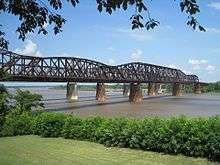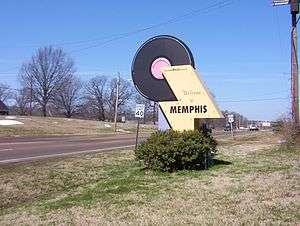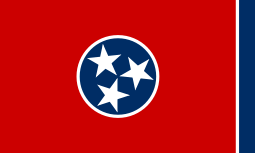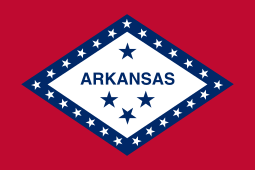Harahan Bridge
| Harahan Bridge | |
|---|---|
 Harahan Bridge from Martyrs Park | |
| Coordinates | 35°07′45″N 90°04′33″W / 35.12917°N 90.07583°W |
| Carries | Single track of Union Pacific Railroad, Pedestrian Bridge |
| Crosses | Mississippi River |
| Locale | West Memphis, Arkansas and Memphis, Tennessee |
| Maintained by | Union Pacific Railroad |
| Characteristics | |
| Design | Cantilevered through Truss bridge |
| Total length | 4,973 feet (1,516 m) |
| Longest span | 791 feet (241 m) |
| Clearance below | 108 feet (33 m) |
| History | |
| Opened | July 14, 1916 |
The Harahan Bridge is a cantilevered through truss bridge[1] that carries two rail lines and a pedestrian bridge across the Mississippi River between West Memphis, Arkansas and Memphis, Tennessee. The bridge is owned and operated by Union Pacific Railroad. It was built with roadways cantilevered off the sides of the main structure for vehicles.[2] These roadways are owned by the cities of Memphis, Tennessee and Crittenden County, Arkansas, and were used from 1917-1949, until the Memphis & Arkansas Bridge opened 400 feet south of the Harahan.[3][4][5] The bridge was named in honor of railroad executive James Theodore Harahan, former president of the Illinois Central Railroad, who was killed in a railroad accident during the construction of the bridge.[6] In February 2011, Union Pacific Railroad officials agreed to the idea of converting the 1917 roadways into a bicycle-pedestrian walkway across the river.[7] [8] In June 2012, Memphis was awarded a $14.9 million federal grant to build the walkway. The overall project is expected to cost $30 million, of which about $11 million will be used for the Harahan Bridge portion.[9] .[10] Construction is underway and should be completed in 2016.
Description
The Harahan Bridge is in total 4,973 feet long while the main bridge is 2,550 feet from the east anchorage on the Memphis Bluffs to Pier 5 on the Arkansas flood plains. An additional 2,363 foot tower and girder viaduct completes the bridge to the west abutment. The longest span is 791 feet over the main channel on the Memphis side of the river. The bridge carries two rail lines and two roadways.[11]
History
The “Great Bridge,” later known as the Frisco Bridge, opened in 1892 and was the first bridge to cross the Mississippi River south of the Ohio River. It was an engineering marvel, carrying a single track across the river. When finished, it was the third longest bridge in the world, but within 20 years of its opening, rail traffic had increased so much that another bridge was needed.[12]
Mayor E.H. Crump met with officials from the Rock Island Railroad on February 5, 1912, to discuss the possibility of a new bridge. The Iron Mountain Railroad and the Cotton Belt Railroad joined and formed the Memphis and Arkansas Bridge and Terminal Company. The plan drew wide support from the Memphis business community, and political leaders were urged to present a bill to Congress for approval of the ambitious project. This plan estimated the cost at $2.6 million and would include $400,000 for wagonways along each side.[13]
Initially, developers of the Rock Island Railroad were not interested in providing vehicular access to their bridge. Newly elected Congressman Kenneth McKellar from Memphis threatened to block the bridge permit if wagonways were not included. This bill also met with opposition in the form of Democratic party leader Oscar Underwood of Alabama. Congressman Underwood’s campaign manager, Edward Campbell, was attorney for the Kansas City Memphis, Memphis & Birmingham Railroad, which was the owner of the “Great Bridge.” The Kansas City Railroad did not want a competing bridge to undermine its monopoly on the Mississippi river crossing. Congressman McKellar led a bipartisan majority to approve the bill.[14]
Leaders in Arkansas resented Memphis dealing with the railroad without their involvement. This was the first attempt in a long running feud over the bridge. Arkansas wanted a “toll-free” bridge that would accommodate trolley lines. In August 1912, a mass meeting was held in Marion, Arkansas. There, the Rock Island Railroad agreed to build a $4 million bridge with wagonways that would be turned over to Crittenden County and the City of Memphis, to be used “without toll for all time.”[15]
On April 10, 1913, Ralph Modjeski was instructed to prepare plans for the bridge in Memphis. A “force” of draftsmen was employed to detail drawings for the substructure and superstructure of the bridge. On May 13, 1913, plans were submitted by the railroad to the U.S. Engineer for approval by the war department.[16]
Of the Harahan’s total length of 4,972 feet, 1,194 feet lie in Tennessee, and 3,778 feet lie in Arkansas. This was based on the state line being set in the center of the Mississippi river during low tide. This disparity on ownership and maintenance was further exacerbated by the addition of 2.5 miles from the end of the bridge to the St. Francis Levee. The total distance from the levee to the South Memphis bluffs was 16,295 feet; only 1,194 feet lay in Memphis, Tennessee.[17]
Construction
The first work was to build two miles of track from an existing line in the Arkansas flood plains to bring materials in place for construction. When this track was complete, 60 cars of timber waited for delivery. This material was used in building barges used for construction and moving materials into place. The first three months of construction were used to build 15 barges, and a total of 21 barges were needed to complete construction.[18]
The next phase of the project involved building massive willow mats. These mats were constructed on the river. When completed, they measured 200 feet x 300 feet. They were floated to the location of the piers (held in place by barges) and sunk to the bottom of the river with rip-rap and stone. The purposed of the willow mats was to reduce scouring, keeping the river bed in place as the pneumatic caissons were dug into the river bed.[19]
The Harahan Bridge was to be located 200 feet north of the Frisco Bridge. Use of pneumatic caissons had been used on the Frisco and other major bridges; this did not eliminate the dangers involved. The Harahan pneumatic caissons were constructed on shore out of wood. The walls were 3 feet thick, with heavy caulking and tar to make them airtight. The caisson was 40 feet wide x 90 feet long x 60 feet tall. In reality, it was a large wooden box, open at the bottom. The chamber at the bottom of the caisson had a 7-foot ceiling for the sandhogs to work.[20]
Digging the river bottoms to sink the caissons into the river bed was difficult and dangerous work. All the material inside the walls of the caisson had to be removed to the surface. The caisson was built with excavation shafts for removing dirt and clay. The pressure was increased to match the water pressure, keeping the river water out of the work area. When the pressure was high enough, the excavation shafts were opened and air pressure would remove the light weight river bottom in a “blow off.” This eased the process greatly and saved a tremendous amount of time and effort for the sand hogs. It did, however, make a spectacular sight as a fountain of river bottom erupted from the caisson, it also left quite a mess on the top of it and any barges nearby.[21]
As the caissons were being sunk into the riverbed, the piers were being built on top of them, adding weight and driving the caisson deeper into the river bottom. The piers were masonry blocks of granite backed with concrete. The piers of the Harahan were located directly upstream of the piers of the Frisco Bridge to keep the navigation channels open to river traffic. Pier IV was moved 17 feet toward the river relative to the Frisco Pier IV. This enabled the engineers to design two suspended spans and three cantilevered arms identically.[22]
With the caissons sunk and the substructure complete, work began on the steel superstructure. The longest span between Pier I and Pier II was the first to be built. This span would be built without falsework, employing two cantilevered arms and a suspended arm. The next span to be complete was between Pier II and Pier III, using temporary falsework wood support timbers driven into the river bottom to hold the fixed span in place until it was complete. The span between Pier III and Pier IV was started concurrently. Span II to III was finished on December 22, 1915. On December 24, 1915, the river rose too quickly and washed away the false work. Span II to III was not damaged, although it moved 8 inches. Span III to IV was completely washed out, forcing a delay in the construction and a redesign on the span.
On July 14, 1916, the first train crossed the bridge. The celebration that had been planned was cancelled due to the war in Europe. The wagonways were not opened until September 17, 1917. The delay was due to construction problems with a wooden viaduct in Arkansas.[23]
Big River Crossing
One of the former roadways on the north side of the bridge is now used to carry pedestrian and bicycle traffic across the Mississippi River. The bridge is a vital part of a larger project that connects Main Street in Memphis to Broadway in West Memphis, Arkansas.[24] In 2016, it was announced that an anonymous donor had pledged $5 million to illuminate the bridge. Upon approval by the United States Coast Guard, the Harahan Bridge will become the second illuminated brige in Memphis, the only one to be illuminated by LED.[25]
Gallery
-

Hanging in the air above the middle of the stream - drawing of the construction of Harahan Bridge, c. 1917.
See also
References
- ↑ Bridge Hunter Historic Bridge Page
- ↑ Modjeski, Ralph, (1917-4-16). "Harahan Bridge at Memphis Tn: Final Report”
- ↑ Shelby County Register of Deeds: Book 0672, Page 466, 8/31/1917
- ↑ Crittenden County Register of Deeds: Book 97, Page 335, 9/10/1918
- ↑ 5. “New Bridge Opens”, Commercial Appeal, 12/18/1949
- ↑ “J.T. Harahan Killed in his Private Car”, New York Times, 1/23/1912
- ↑ “Union Pacific Railroad will cooperate in effort to build walkway across Harahan Bridge”, Commercial Appeal, 2/4/2011
- ↑ “New Harahan Bridge Across the Mississippi River at Memphis”, Rock Island Employees Magazine, March 1915, B.M. Case, Resident Engineer
- ↑ , “Memphis gets $14.9M grant to help build pathway across Harahan Bridge “, Commercial Appeal, 6/19/2012
- ↑ WREG: Bicycler Killed on Interstate Coming From Work
- ↑ Modjeski, Ralph, (1917-4-16). "Harahan Bridge at Memphis Tn: Final Report”
- ↑ “Frisco Bridge; Mississippi River Crossing at Memphis”, John A. Weeks, johnweeks.com, 2008
- ↑ “Harahan built to meet Traffic needs”, Commercial Appeal, 1/22/98, Perre Magness
- ↑ “Harahan built to meet Traffic needs”, Commercial Appeal, 1/22/98, Perre Magness
- ↑ “Harahan built to meet Traffic needs”, Commercial Appeal, 1/22/98, Perre Magness
- ↑ Modjeski, Ralph, (1917-4-16). "Harahan Bridge at Memphis Tn: Final Report”
- ↑ “Harahan Span costs listed by Arkansas”, Commercial Appeal, 5/10/49
- ↑ “New Harahan Bridge Across the Mississippi River at Memphis”, Rock Island Employees Magazine, March 1915, B.M. Case, Resident Engineer
- ↑ “New Harahan Bridge Across the Mississippi River at Memphis”, Rock Island Employees Magazine, March 1915, B.M. Case, Resident Engineer
- ↑ Modjeski, Ralph, (1917-4-16). "Harahan Bridge at Memphis Tn: Final Report”
- ↑ Modjeski, Ralph, (1917-4-16). "Harahan Bridge at Memphis Tn: Final Report”
- ↑ Modjeski, Ralph, (1917-4-16). "Harahan Bridge at Memphis Tn: Final Report”
- ↑ “Harahan built to meet Traffic needs”, Commercial Appeal, 1/22/98, Perre Magness
- ↑ Sells, Toby. "West Memphis Plans For Big River Crossing". Memphis Flyer. Retrieved 2016-01-01.
- ↑ "Harahan Bridge lighting has private backers". www.commercialappeal.com. Retrieved 2016-05-21.
Articles
03/19/14 Railroad expenditures,
07/15/16 New Mississippi River Bridge at Memphis (railway age gazette) engineering article from “Railway age gazette
1/7/17 The Harahan bridge at Memphis, TN (Journal of the franklin institute)
09/05/17 J.T. Harahan bridge is opened to Public, (2) RULES, orderly and keep moving
10/2/24 The Toll gates, tolls must stop, new viaduct to be built
1/31/28 Harahan Viaduct nearing reality amid Titanic toll, 2,000 yards of dirt moved/24 hours, 1/3 done,
09/18/28 How flames wrecked Harahan
9/18/28 Plans rushed for rebuilding burned bridge, trains and ferries operate, fire burns roadway damages bridge, $850,000, trains and ferries used
9/18/28 Train and ferry to bridge Mississippi, Frisco will operate Auto cars
11/2/28 Modjeski, the master, sees his first work---Harahan, “it a good bridge”, trouble with construction discussed
05/04/29 Tolls raise 317,536, will help pay for new viaduct
6/29/29 Heavy repairs required after Fire
2/16/30 Opening of new viaduct will be big event
07/11/30 First traffic routed on Harahan viaduct, gateway between Memphis and west I opened, replaces old wooden viaduct, toll ended
7/10/30 Traffic Flows over finished Harahanspan, long dream realized,
07/11/30 First traffic routed on Harahan Viaduct, apx $1,500,000, toll ended
7/19/30 Viaduct opening ends 14 long years effort, old wooden structure used 6 years before thought of concrete approach advanced,
01/17/31 New Harahan blow to ark budget, Paid $700000 over, cost 1,628,374, old viaduct tolls raised $736,737 from 7/27 to 10/30
06/09/31 Wooden viaduct dismantled, lumber salvaged, convict labor used
03/08/35 Harahan planking needs replacement, only 6 years old
3/10/35 Repair to Harahan will be discussed
3/10/35 Finish the Job, Bridge planks under repair, 3 workmen
3/15/35 Harahan roadway repairs to be made,
03/13/35 bridge repairs planned, $1,100 to TN, 2,400 to ARK
04/03/35 Repair Bridge as needed, bad boards to be replaced at night
07/17/35 Slow traffic, one traffic lane open, 15 min wait
8/2/35 Suggests surfacing for roads on bridge, would use asphalt and stone
3/30/36 daredevil diver plunges 105 feet into river, Ray Woods, 20,000 spectators, football helmet
03/27/37 Fight endless battle against rust and river, (5) men patrol bridge, (24) hours a day, fire watch, bridge cost $6,000,000 to build
04/22/37 Harahan to get new flooring, ark call for bids,
06/26/37 Agreement reached, heavy vehicles spaced at 100 feet, unnecessary strain, recommended by Crump,
08/19/37 Traffic of Hundreds of American Highways crosses Harahan on two 12-foot drives, discussion of a new bridge, 10,000 – 12,000 cars per day, may double soon
8/22/37 protest on closing bridge of no avail, cotton exchange protest repair during busy season
8/23/37 Why it’ll take longer to cross the river now, 60 days, $94,000
082437 Ark will hear protest on bridge job,steel strikes delay work 3 months, $95,000, delay not due to dog racing season, repair curing cotton season, not dog season.
8/24/37 Cotton vs. Dogs, repairs delayed until dog season ended and cotton picking began
9/2/37 letter admits dogs delayed bridge repairs, $1,000,000 gambled during
09/07/37 railroads unwilling to transport pickers, bridge under repair, liability (race?)
09/10/37 Slow men at work. Bridge repairs taking long time.
09/14/37 Two bridge idea spiked by Frisco, No chance to covert Frisco Bridge to a highway bridge.
09/15/37 Repairs Completed on Harahan Runway
9/16/37 Harahan to resume 2-way operation
9/16/37 They Talked it Over
09/16/37 2-way traffic resumed, south side needs repair
10/21/37 Go as you please on Harahan Bridge, Repairs complete, 2 months, Arkansas side complete, $125,000, tongue and groove flooring, with asphalt on top, new steel girders TN may need work,
8/30/38 Harahan Bridge no long adequate to take care of heavy auto traffic, survey for new structure points out”, (4) lane bridge proposed,$3,500,000 estimate. 5,000 cars/day in 1934, 9,000 in 1938,… Harahan bridge plans started in 1911, 1913 Memphis was paid $50,000 to close certain streets, 15,000 tons of steel, 200 feet north of Frisco bridge,
10/07/38 Repairs on Harahan sought in Memphis, soft timber used in last repair (1 year) bolts loose
10/23/38 River scours out deep hole beneath the Harahan bridge, engineers express no fears, painted every (5) years, paint cost $35,000, 40-70 trains per day, 125 per day during flood of 1937
12/10/38 roadway proposed over Frisco Bridge, Ark unwilling to pay for 25%
12/23/38 Harahan Span Cost Listed by Arkansas, Ark near$2,000,000, TN spent #356,554
03/17/39 Plans for new bridge bring to mind difficulties that beset work on Harahan, 120539 Harahan approach carries heaviest traffic in state, 6,900/day
1/13/40 Ark to TN, ‘spend more on Harahan’ TN 1,184’, ARK, 3,658’,
12/24/40 Patrol is organized for Harahan Bridge, 24-hour watch, overloading and sabotage,
05/26/40 Watch Maintained at Harahan Bridge. (2) watchman per shift
2/23/41 251,285 for 30 days is count on Harahan, 8,376/day,
10/1/42 Joint Maintenance of Harahan OK-ed, TN & Ark to work together
10/3/42 Bridge Maintenance to be discussed. no weigh station in Memphis.
10/18/47 Breakdown Schedule on Harahan is Fixed, emergency vehicles service
7/11/42 Army may assume guard of Harahan, Mayor Chandler asks army
12/16/42 Increase Safeguards Around Harahan Bridge
10/19/46 1928 fire recalled
12/19/46 Length of Harahan Bridge, viaduct 2.25 miles all in ark, 17,489 feet from bluffs to levee, 16,295 feet in Arkansas
12/24/46 prevent overloading and sabotage, trucks 250’, 300’ apart
05/10/49 Bridge was named for IC president, married to the Mallory family
4/8/49 Celebration refund of $100,000 due to war (See “Notes on Court Case Document”)
4/21/50 Ark TN to Abandon Harahan, roadways in disrepair, little used.
5/8/51 Ark half of Harahan roadways to be torn up
5/9/51 “Save Bridge Says Crump”
5/10/51 Mayor makes appeal to preserve Harahan, Overton makes statement
5/11/51 Judge says wrecking of Harahan to start: city may file suite
5/12/51 Bridge roadways ‘hazard says ark engineer”, wood aid to sabotage
5/13/51 Owners of Harahan fight for roadways, advised it might be violating act, “deviation from the plan” -could it be argued that not having serviceable roadways currently is a deviation from the plan
5/18/51 Memphis will seek injunction to stop Harahan wrecking, fight goes to federal court
6/1/51 Federal government files suit to retain Harahan roadways, national defense, needs congress consent.
6/2/51 Technicality delay met in court suit on bridge roadways
6/5/51 Bridge Road hearing is set
6/7/51 Memphis considered prime target area Carley tells court
7/21/51 Crittenden is winner in roadways dispute
4/3/52 Memphis Wins round on bridge roadways, US appeals court orders injunction suit heard, decision reversed, stay ordered, expenses cited,
11/4/52 Boxcar Bales ignite, Bridge set afire, Harahan watchman save the day,
12/13/52 Bridge approach had a $0.25 toll, Harahan viaduct,
4/1/53 Remember the Harahan viaduct,
3/12/54 Five rulings against city on Harahan,
4/21/54 Crittenden wins tilt on bridge roadways
4/23/54 Memphis continues battle for bridges, to appeal AK ruling, fights dismantling
5/19/54 A legal victory in bridge fight, roadways saved for a time
10/1/54 yawning holes dot rotting Harahan roads, Old Bridge can still be made safe for use, “the steel work appears to be in excellent condition”
12/10/54 Agreement reached on Harahan Bridge, steelwork to be maintained for 10 years, 10 years of standby
4/2/55 Commission puts OK on Harahan Contract4/10/58 Traffic Rattled Harahan Viaduct, used 12 years, $0.25 per trip (see notes Bike Crossing document)
7/7/62 Veteran guard has seen lot on ‘lonely Harahan patrol,
11/16/62 lonely Figure on windswept bridge, bridge fire patrol, 4 leap to death, 23 lost their lives building the bridge,
7/14/63 lonely Harahan Bridge patrolman prefers winter sting to summer,
3/8/65 Busy Harahan Girders Echo Past, (1929 new steel added to support road bed?)
5/31/67 “Backup Bridge to be studied”, engineers to examine idea of restoring roadways to railroad span, recent accidents on the new bridge and increased congestion led former county commissioner Rudolph Jones to investigate this possibility.
6/29/67 “Harahan job estimated at 1.5 million”, project would take 2 years, new $50 million, 6-lane bridge being discussed
7/1/67 “Harahan will rust in peace”, high cost scraps project, cost not justifiable with new bridge (Hernado Desoto) opening in 72’
7/25/67 Fought for free bridge, Zach Taylor died, he fought for the toll free viaduct.
5/7/71 Bridge Proposed as tourist Mecca, plans for amusement park on Hopefield point, shops on the western end of the bridge,
8/16/71 “Bridge park Committee Selected”, theme park on the Harahan, L.H. (Pop) Popenheimer selected as chairman, walkway with a national park at either end, shops on the western end,
4/8/72 “Bomb squad called” when (14) sticks of deteriorating dynamite were found in a concrete bunker.
12/21/75 “Plan for Harahan”, Mrs. Ann Bowen area planner for MATCOG, (Mississippi Arkansas Tennessee council of Governments), bikeway planned on each side of bridge.
3/6/76 “MATCOG unveils plans for hiking-Bicycle Bridge,”, 1.2 million, local funding an issue
4/3/77 Harahan Viaduct History
8/9/71 established in the neighborhood,
2/22/94 “Harahan is closed briefly”, a safety precaution, towboat engine sideswiped pier,
2/11/99 “Old Harahan Bridge may get new life as trans-river bike trail”, $400,000 for (2) lanes, Cynthia Buchanan “You’ve already got the darn bridge. It's not going to cost a whole lot to put the road back”, impetus came for the MRT. (page 2 of this article)
2/14/2002 “Fire Damage timbers, automobiles on train on Harahan Bridge”, small fire sparked from passing train ignited timber on the bridge.
External links
| Wikimedia Commons has media related to Harahan Bridge. |
- The Interesting and Unusual Story of the Harahan Bridge
- Recent Photos of the Harahan Bridge
- Harahan Bridge Automobile Ramp Photo
- Harahan Bridge Project Website






